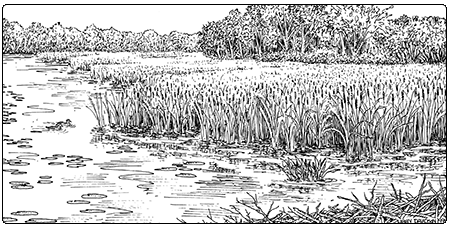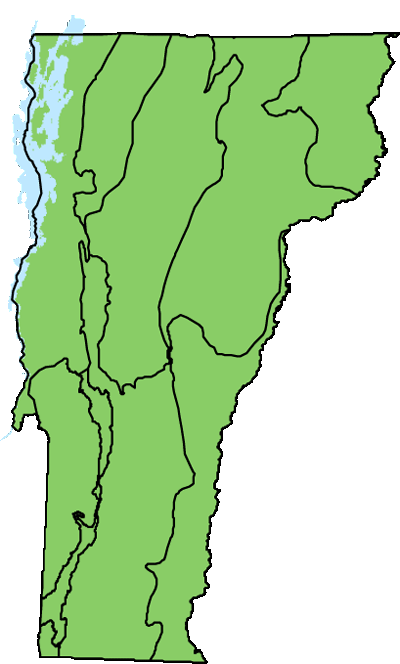Ecology and Physical Setting 
Cattail Marshes are easily identified by their namesake four- to eight-foot tall plants with long, graceful leaves and a flowering stalk that bears the familiar “cattail.” Although these wetlands appear as uniform and monotonous stands of common and narrow-leaved cattails, they are in fact highly productive ecosystems that provide significant ecological functions. These wetlands store flood waters, maintain surface water quality, and provide important wildlife habitat for many species.
Cattail Marshes are found throughout Vermont but are most common in the fertile lowlands of the Champlain Valley. They range in size from less than one acre in small depressions to over 500 acres along the shores of Lake Champlain. In addition to poorly drained depressions and wave-sheltered bays along lake and pond shores, Cattail Marshes also occur in backwater floodplains of rivers and streams.
 Cattail Marshes are frequently part of larger wetland complexes. In areas of shallow water and saturated soil they commonly mix with Shallow Emergent Marshes and Alder Swamps. In deep water areas, Cattail Marshes form mosaics with Deep Broadleaf Marshes and Deep Bulrush Marshes.
Cattail Marshes are frequently part of larger wetland complexes. In areas of shallow water and saturated soil they commonly mix with Shallow Emergent Marshes and Alder Swamps. In deep water areas, Cattail Marshes form mosaics with Deep Broadleaf Marshes and Deep Bulrush Marshes.
In most cases, Cattail Marshes are inundated with shallow water six to eighteen inches deep for much of the growing season, although water levels may drop in many marshes by late summer, leaving soils simply saturated. The soil substrate is well-decomposed muck or high-organic content mineral soil. Cattails can tolerate substantial changes in water levels and are quick to colonize and dominate new areas of suitable habitat.
During the peak of agricultural clearing in the 19th century, increased farmland runoff and sedimentation led to an expansion of cattails in marshes. At the same time, narrow-leaved cattail started spreading from its coastal saltwater habitat to inland calcareous waters and disturbed and eutrophic settings. It is unclear if narrow-leaved cattail is even native to North America. It continues to spread today, especially in roadside ditches because of its salt tolerance. Narrow-leaved cattail crosses with common cattail, and the resulting hybrid is especially successful in colonizing polluted marshes.
Vegetation
Common cattail and narrow-leaved cattail spread aggressively by rhizomes and form extensive colonies or clonal patches. The density of the cattails restricts other plant species from becoming established. Common cattail is the most abundant species, but it is mixed with narrow-leaved cattail in some marshes, especially in the Champlain Valley. Other emergent plants that may be locally abundant include giant bur-reed, water parsnip, spotted water hemlock, bulb-bearing water hemlock, and water horsetail. In shallow water, woolgrass may mix with the cattails, whereas in deeper water, aquatic bulrushes and pickerelweed may mix with cattails. Bryophyte cover is low or absent in Cattail Marshes, likely due to the fluctuating water levels.
Wildlife Habitat
Wildlife is abundant in Cattail Marshes. Frogs that prefer deeper water include gray treefrog, American bullfrog, and green frog. Spring peepers and northern leopard frogs may be found in marshes with shallower water. Common watersnakes are excellent swimmers; they feed on frogs and small fish. These large snakes bask on logs and other perches but are also known to climb and hang from cattail stems.
Songbirds that nest in Cattail Marshes include marsh wren, swamp sparrow, and red-winged blackbird. Great blue herons, green herons, and black-crowned night herons (in the Champlain Valley) may be observed wading and hunting for prey. Many marsh birds nest in Cattail Marshes; these include Virginia rail, least bittern, American bittern, sora, pied-billed grebe, common gallinule, and American coot. Nesting waterfowl include mallards, black ducks, and blue-winged teal. Northern harriers glide low and slow over larger marshes and open fields, hunting for small birds and mammals. They nest on the ground on dry hummocks.
The very rare, state-endangered black tern nests in small colonies in large Cattail Marshes and other shallow marshes near Lake Champlain. This graceful, small, dark tern has declined in Vermont and throughout its range. Black terns build precarious nests on floating mats of plant material to avoid predators.
Muskrats use cattails as a food supply and as building material for their small, conical lodges. The industrious activity of a colony of these rodents can be a major form of natural disturbance in Cattail Marshes, resulting in a mosaic of open water and vegetation that provides ideal waterfowl habitat.
Related Communities
- Shallow Emergent Marsh has less standing water than Cattail Marsh. It contains a greater richness of herbaceous plants, but cattails are rarely present.
- Deep Broadleaf Marsh often occurs in a mosaic with Cattail Marsh but contains deeper standing water and is dominated by pickerelweed and arrowheads.
- Deep Bulrush Marsh may also occur adjacent to and intergrade with Cattail Marsh. It is typically exposed to wave action, occurs in deeper water than Cattail Marsh, and is dominated by aquatic bulrushes.
Conservation Status and Management Considerations
Cattail Marshes are generally thought of as being very resilient to human disturbance. They can tolerate substantial alterations of hydrologic regimes and inputs of stormwater runoff. However, on closer inspection, these types of impacts can further reduce the already low diversity of plant species in a marsh, resulting in near monocultures of cattails. Viewed from another perspective, many of the large Cattail Marshes in the Champlain Valley are in part the result of past hydrologic manipulation and excessive nutrients associated with agricultural runoff. These types of impacts, as well as loss of adjacent upland buffers and connections to other wetlands and upland forests, can also significantly reduce the quality of wildlife habitat provided by Cattail Marshes. Many of our largest Cattail Marshes are located on public or conservation lands, but most occur in watersheds that have extensive areas of agriculture.
Distribution/Abundance 
Cattail Marshes occur throughout Vermont but are most common at lower elevations. Similar communities dominated by cattails occur across eastern North America.
Characteristic Plants
Herbs
Abundant Species
Common cattail – Typha latifolia
Occasional to Locally Abundant Species
Narrow-leaved cattail – Typha angustifolia
Giant bur-reed – Sparganium eurycarpum
Water parsnip – Sium suave
Spotted water hemlock – Cicuta maculata
Bulb-bearing water hemlock – Cicuta bulbifera
Water horsetail – Equisetum fluviatile
Northern bugleweed – Lycopus uniflorus
American water horehound – Lycopus americanus
Woolgrass – Scirpus cyperinus
Soft-stem bulrush – Schoenoplectus tabernaemontani
Hard-stem bulrush – Schoenoplectus acutus
River bulrush – Bolboschoenus fluviatilis
Pickerelweed – Pontederia cordata
Swamp milkweed – Asclepias incarnata
Monkey-flower – Mimulus ringens
Common duckweed – Lemna minor
Southern wild rice – Zizania aquatica
Non-native Invasive Plants
Hybrid cattail – Typha ×glauca
Purple loosestrife – Lythrum salicaria
Phragmites – Phragmites australis ssp. australis
Flowering rush – Butomus umbellatus
Associated Animals
Gray treefrog – Hyla versicolor
Spring peeper – Pseudacris crucifer
Northern leopard frog – Lithobates pipiens
American bullfrog – Lithobates catesbeianus
Green frog – Lithobates clamitans
Snapping turtle – Chelydra serpentina
Painted turtle – Chrysemys picta
Muskrat – Ondatra zibethicus
Mink – Neovison vison
Marsh wren – Cistothorus palustris
Red-winged blackbird – Agelaius phoeniceus
Swamp sparrow – Melospiza georgiana
Wood duck – Aix sponsa
Mallard – Anas platyrhynchos
Virginia rail – Rallus limicola
Great blue heron – Ardea herodias
Green heron – Butorides virescens
Lance-tipped darner – Aeshna constricta
Canada darner – Aeshna canadensis
Spotted spreadwing – Lestes congener
Cherry-faced meadowhawk – Sympetrum internum
Rare and Uncommon Animals
Eastern ribbonsnake – Thamnophis sauritus
Common watersnake – Nerodia sipedon
Least bittern – Ixobrychus exilis
American bittern – Botaurus lentiginosus
Black-crowned night-heron – Nycticorax nycticorax
Sora – Porzana carolina
Pied-billed grebe – Podilymbus podiceps
Common gallinule – Gallinula galeata
Black tern – Chlidonias niger
American coot – Fulica americana
American black duck – Anas rubripes
Blue-winged teal – Anas discors
Northern harrier – Circus hudsonius
Places to Visit
Drowned Lands, West Haven, Helen W. Buckner Preserve at Bald Mountain, The Nature Conservancy (TNC)
East Creek Natural Area, Orwell, TNC
South Bay Wildlife Management Area, Coventry, Vermont Fish and Wildlife Department (VFWD)
Shelburne Pond Natural Area, Shelburne, University of Vermont and TNC
Mud Creek Waterfowl Area, Alburgh, VFWD
Fairfield Swamp Wildlife Management Area, Fairfield, VFWD
Lower Otter Creek Wildlife Management Area, Ferrisburgh, VFWD
Missisquoi National Wildlife Refuge, Swanton and Highgate, U.S. Fish and Wildlife Service
